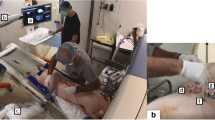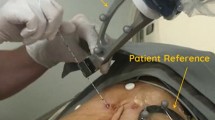Abstract
Purpose
This study aimed to evaluate the accuracy and safety of robotic CT-guided needle insertion in phantom and animal experiments.
Materials and Methods
A robotic system was developed for CT-guided needle insertion. For the phantom experiment, a specially made phantom containing multiple spherical was used. 15 robotic and manual insertions were conducted, and the accuracy, time, number of needle insertions, and radiation dose were compared between the robotic and manual insertion using Student’s t-test. For the animal experiment, 20 robotic needle insertions were attempted toward simulated pulmonary nodules in the swine lung. The accuracy and safety of robotic CT-guided needle insertions were evaluated.
Results
In the phantom experiment, the mean accuracies of manual and robotic insertion were 1.8 ± 0.3 mm and 1.9 ± 0.2 mm. The accuracy of robotic needle insertion had no significant difference with manual needle insertion, but the number of needle insertions and radiation dose of the robotic needle placement significantly decreased compared to manual needle placement. In the animal experiment, the mean accuracy of the robotic needle insertion was 3.8 ± 1.3 mm. The time for the whole needle insertion was 14.4 ± 4.8 min. The whole robotic needle insertions were safe and only one mild pneumothorax occurred.
Conclusion
CT-guided robotic needle insertion showed accuracy comparable to manual needle insertion, but the number of needle insertions, confirmatory scans, and radiation exposure had been reduced significantly. In future, we will further apply the robotic system to clinical experiments.






Similar content being viewed by others
References
Markelj P, Tomaževič D, Likar B, et al. A review of 3D/2D registration methods for image-guided interventions. Med Image Anal. 2012;16(3):642–61.
Phillips WT, Bao A, Brenner AJ, et al. Image-guided interventional therapy for cancer with radiotherapeutic nanoparticles. Adv Drug Deliv Rev. 2014;76:39–59.
Sarti M, Brehmer WP, Gay SB. Low-dose techniques in CT-guided interventions. Radiographics. 2012;32(4):1109–19.
Tai R, Dunne RM, Trotman-Dickenson B, et al. Frequency and severity of pulmonary hemorrhage in patients undergoing percutaneous CT-guided transthoracic lung biopsy: single-institution experience of 1175 cases. Radiology. 2016;279(1):287–96.
Wolf FJ, Dupuy DE, Machan JT, et al. Adrenal neoplasms: effectiveness and safety of CT-guided ablation of 23 tumors in 22 patients. Eur J Radiol. 2012;81(8):1717–23.
Arellano RS, Gervais DA, Mueller PR. CT-guided drainage of abdominal abscesses: hydrodissection to create access routes for percutaneous drainage. Am J Roentgenol. 2011;196(1):189–91.
Suzuki K, Shimohira M, Hashizume T, et al. Usefulness of CT-guided hookwire marking before video-assisted thoracoscopic surgery for small pulmonary lesions. J Med Imaging Radiat Oncol. 2014;58(6):657–62.
Li Q, Liu P, Qi L, et al. A system design of image-guided automated surgery robot. IEEE Int Conf Real-time Comput Robot (RCAR). 2017;2017:378–82.
Putzer D, Arco D, Schamberger B, et al. Comparison of two electromagnetic navigation systems for CT-guided punctures: a phantom study. Rofo. 2016;188(5):470–8.
Beyer LP, Wiggermann P. Planning and guidance: new tools to enhance the human skills in interventional oncology. Diagn Interv Imaging. 2017;98(9):583–8.
de Baere T, Roux C, Noel G, et al. Robotic assistance for percutaneous needle insertion in the kidney: pre interventional surgery proof on a swine animal model. Eur Radiol Exp. 2022;6(1):1–7.
Fong AJ, Stewart CL, Lafaro K, et al. Robotic assistance for quick and accurate image-guided needle placement. Updat Surg. 2021;73(3):1197–201.
Mbalisike EC, Vogl TJ, Zangos S, et al. Image-guided microwave thermoablation of hepatic tumours using novel robotic guidance: an early experience. Eur Radiol. 2015;25(2):454–62.
Abdullah BJ, Yeong CH, Goh KL, et al. Robotic-assisted thermal ablation of liver tumours. Eur Radiol. 2015;25(1):246–57.
Smakic A, Rathmann N, Kostrzewa M, et al. Performance of a robotic assistance device in computed tomography-guided percutaneous diagnostic and therapeutic procedures. Cardiovasc Interv Radiol. 2018;41(4):639–44.
Groetz S, Wilhelm K, Willinek W, et al. A new robotic assistance system for percutaneous CT-guided punctures: initial experience. Minim Invasive Ther Allied Technol. 2016;25(2):79–85.
Hiraki T, Kamegawa T, Matsuno T, et al. Zerobot®: a remote-controlled robot for needle insertion in CT-guided interventional radiology developed at Okayama university. Acta Med Okayama. 2018;72(6):539–46.
Hiraki T, Kamegawa T, Matsuno T, et al. Robotically driven CT-guided needle insertion: preliminary results in phantom and animal experiments. Radiology. 2017;285(2):454–61.
Guiu B, De Baère T, Noel G, et al. Feasibility, safety and accuracy of a CT-guided robotic assistance for percutaneous needle placement in a swine liver model. Sci Rep. 2021;11(1):1–11.
Lanouzière M, Varbédian O, Chevallier O, et al. Computed tomography-navigation™ electromagnetic system compared to conventional computed tomography guidance for percutaneous lung biopsy: a single-center experience. Diagnostics. 2021;11(9):1532.
Tacher V, Blain M, Hérin E, et al. CBCT-based image guidance for percutaneous access: electromagnetic navigation versus 3D image fusion with fluoroscopy versus combination of both technologies—a phantom study. Cardiovasc Interv Radiol. 2020;43(3):495–504.
Zhang Z, Shao G, Zheng J, et al. Electromagnetic navigation to assist with computed tomography-guided thermal ablation of liver tumors. Minim Invasive Ther Allied Technol. 2020;29(5):275–82.
Huo YR, Chan MV, Habib AR, et al. Pneumothorax rates in CT-guided lung biopsies: a comprehensive systematic review and meta-analysis of risk factors. Br J Radiol. 2020;93(1108):20190866.
Wiener RS, Wiener DC, Gould MK. Risks of transthoracic needle biopsy: How high? Clin Pulm Med. 2013;20(1):29.
Funding
This study was funded by Beijing TrueHealth Medical Technology Co., Ltd.
Author information
Authors and Affiliations
Contributions
XC designed the study and edited the final manuscript. YY and AL collected the data, performed a literature review, and produced the draft manuscript. TW helped with the writing of the manuscript. YW conceived the study. All authors have read and agreed to the published version of the manuscript.
Corresponding author
Ethics declarations
Conflict of interest
The authors declare no conflict of interest.
Ethical Approval
The animal experiment was approved by the Experimental Animal Ethics Committee of Silver Snake (Guangzhou) Medical Technology Co., Ltd.
Informed Consent
For this type of study, informed consent is not required.
Consent for Publication
For this type of study, consent for publication is not required.
Additional information
Publisher's Note
Springer Nature remains neutral with regard to jurisdictional claims in published maps and institutional affiliations.
Rights and permissions
Springer Nature or its licensor (e.g. a society or other partner) holds exclusive rights to this article under a publishing agreement with the author(s) or other rightsholder(s); author self-archiving of the accepted manuscript version of this article is solely governed by the terms of such publishing agreement and applicable law.
About this article
Cite this article
Chen, X., Yan, Y., Li, A. et al. Robot-Assisted Needle Insertion for CT-Guided Puncture: Experimental Study with a Phantom and Animals. Cardiovasc Intervent Radiol 46, 128–135 (2023). https://doi.org/10.1007/s00270-022-03301-0
Received:
Accepted:
Published:
Issue Date:
DOI: https://doi.org/10.1007/s00270-022-03301-0




